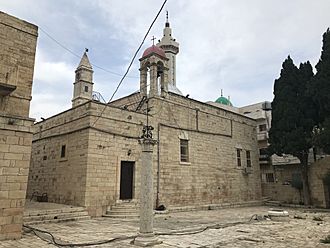Feast of Saint George (Palestine) facts for kids
Quick facts for kids Feast of Saint George |
|
|---|---|

Al Khader monastery
|
|
| Observed by | Palestinian Christians and Muslims in Bethlehem-area |
| Type | Popular feast day |
| Significance | Requests from Saint George (al-Khader) for protection |
| Observances | Ritual animal sacrifice, children's baptism, offering of meat to others |
| Date | 5 May-6 May |
| Related to | Saint George's Day |
The Feast of Saint George is a special holiday celebrated by Palestinians. It honors Saint George, who is also known as Mar Jeries, Jirjis, or al-Khader in Palestinian Arabic. This celebration happens every year on May 5th. Even though it started as a Christian holiday, both Palestinian Christians and Muslims join in the fun. The main celebration takes place in the town of al-Khader, which is near Bethlehem.
Origins of the Feast
People in Palestine tell an old story about how this feast began. It dates back to the time when the Byzantine Empire ruled the land.
The story says that young men were making promises to offer gifts. One said he would give a goat, another a sheep. A young man named Jirjis (also called Jeries) wanted to offer something too.
Jirjis was the son of a widow, and they only had one cow. He decided to sacrifice their cow. When his mother asked where the cow was, he said he gave it to El Khader (Saint George).
His mother was very upset, saying he had ruined their lives. That night, Jirjis had a dream. A wise old man appeared and told him not to be afraid. The man said, "I am El Khader. You will go to Constantinople and to the king's palace. Just remember to bless me every day."
Religious Traditions
The Feast of Saint George is a time for many special traditions. Both Christians and Muslims take part in different ways.
Christian Traditions
In the past, many Arabs from all over Palestine would visit the Monastery of Saint George. They would trade bread, make promises, and have picnics under the olive trees.
Today, this tradition continues. Many Christian visitors come to the monastery to baptize their children. This is because people believe Saint George has healing powers.
The priests at the monastery accept meat as gifts. However, the monastery itself does not sacrifice animals. On the morning of May 6th, Palestinian Christians from nearby towns like Beit Jala, Bethlehem, and Beit Sahour march in a procession to the monastery.
Islamic Traditions
Traditionally, Muslims stand at the church entrance and welcome the visitors. Like the Christians, Muslims also sacrifice sheep during the feast. These offerings are kept in a special pen in the monastery garden.
In Islam, two types of sacrifices are made. The first is called dhabihah. For this, one-third of the sacrificed lamb is eaten by its owner. The other two-thirds are given to Allah as charity.
The second offering is a live animal, given as a gift to Saint George. You can see signs of Muslim traditions around the monastery. Lamb hides are sometimes left on the balustrades to dry, showing where sacrifices have taken place.
See also
 In Spanish: Fiesta de San Jorge (Palestina) para niños
In Spanish: Fiesta de San Jorge (Palestina) para niños


